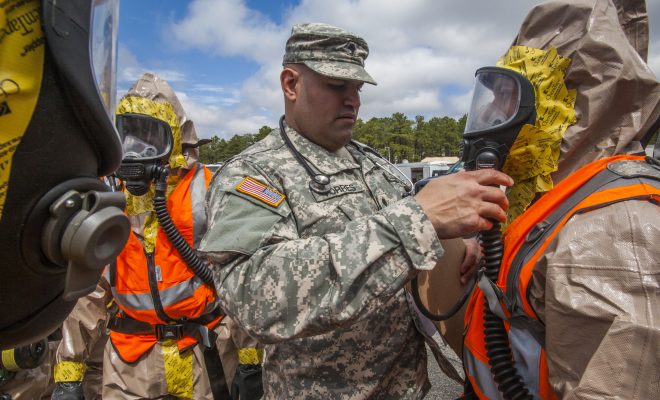 Image courtesy of [New Jersey National Guard via Flickr]
Image courtesy of [New Jersey National Guard via Flickr]
Law
The Forgotten WMDs: Chemical Weapons
In discussions of international politics, we hear a lot of talk about nuclear weapons, but another deadly type of weapon often goes overlooked. Chemical weapons have both proven their deadliness on the battlefield and have been deployed with greater frequency in contemporary times. Nevertheless, just two-and-a-half years since President Obama made his infamous “Red Line” speech against the use of chemical weapons in Syria, this issue has drifted from the public consciousness. While interest has waned publicly, these weapons are still being used on battlefields across the globe, even as legislation and efforts are being made to eliminate them for good. Read on to learn about chemical warfare, the legal framework for using chemical weapons, and how successful efforts to eliminate them have been.
History of Chemical Warfare
While chemical weapons in rudimentary forms have been in use for millennia, it was only relatively recently that they were harnessed in a modern sense. Chemical weapons made their debut on the stage of WWI. During that war, toxic gases such as chlorine and mustard gas were released from canisters on the battlefield. The results were devastating for two reasons. Not only were chemical weapons responsible for over a million causalities on the battlefield, but they also left a strong impression on the public’s consciousness. The video below explains the use of chemical warfare, particularly in WWI.
Nevertheless the use of the weapons continued through the inter-war years, particularly in places such as Russia and Africa. Usage was ramped up again in WWII. In the Far East, the Japanese used a variety of chemical agents in their attempted conquest of China. Meanwhile, in the Atlantic theater, chemical weapons were used by a number of parties, most notoriously by the Nazis in their death camps.
Even after WWII chemical weapons continued to be used. In one of the most glaring instances, the United States used instruments such as Agent Orange in Vietnam. The Americans were not alone, as the Soviets later employed chemical weapons in Afghanistan. Iraq utilized the deadly agents in its war against Iran as well as against its own Kurdish citizens.
Additionally, the usage of chemical weapons by individuals and terrorist groups has become a concern too. The most prominent example came in Japan in 1995, when the Aum Shinrikyo cult used nerve agent Sarin in a Tokyo subway. Chemical weapons were also used by terrorists in Iraq and Afghanistan during the American occupation. Even ISIS has deployed chemical weapons in its battles against Iraqi and Kurdish soldiers.
The most recent high profile and controversial use occurred in Syria in 2013. In late March it was reported that the use of chemical weapons had been detected. While both the Syrian military and the rebels denied using the weapons, each blaming the other side, the usage of chemicals had crossed what President Obama called a “red line.”
While the episode in Syria was just one in a long line of chemical weapons attacks, it aroused concern over whether the existing framework to prevent the creation and use of chemical weapons was adequate. So, what is that framework?
Legality of Chemical Weapons
The horror of chemical weapon usage in WWI left a lasting image in the minds of many people. Thus in 1925, the first legislation aimed at prohibiting the dissemination of chemical weapons was passed. This was known as the Geneva Protocol and it prohibited the use of chemical weapons in warfare. However, the treaty proved inadequate in several ways as it allowed for the continued production of chemical weapons. Additionally, it also gave countries the right to use chemical weapons against non-signatories and in retaliation if weapons were used against them.
The Chemical Weapons Convention
Although seemingly inadequate, the Protocol nonetheless proved to be the only protection against chemical weapons for the next 65 years. Finally in 1992 however, the Chemical Weapons Convention was adopted. It was subsequently opened for signature beginning in 1993 and put into force in 1997. Unlike the Geneva Protocol, the CWC has a much clearer and all-encompassing goal: eliminate an entire category of weapons of mass destruction.
Namely what the treaty calls for is the prohibition of the “development, production, acquisition, stockpiling, retention, transfer or use of chemical weapons by states parties.” The chemicals themselves are divided into three different schedules, which may sound similar to those familiar with the U.S. drug classification regime. In addition, the signatories are responsible for enforcing these protocols within their own countries. Along with stopping the production of chemical weapons, states are required to destroy existing stockpiles and production facilities. Lastly, states are obligated to create a verification system for chemicals and must open themselves to snap inspections by other members. The video below details which chemicals are banned and what the CWC requires of its members.
Chemical Weapons Prohibition Regime: Success or Failure?
So is the current chemical weapons convention (CWC) a success or failure? Different metrics tell different stories.
Arguments for Success
Membership in the treaty certainly casts a positive glow. As of 1997 when the treaty took effect, 190 countries had joined with only five–Israel, Egypt, North Korea, Angola, and South Sudan–not yet ratifying the treaty. Furthermore, real progress has been made in implementing a number of the treaty’s goals. As of 2007, 100 percent of chemical weapons sites had been “deactivated,” 90 percent of which had either been destroyed or switched to peaceful use. Additionally, over 25 to 30 percent of stockpiles had been destroyed and 2,800 inspections had been carried out. The map below indicates countries’ signing status: light green indicates that the country signed and ratified the CWC, dark green indicates that the CWC is acceded or succeeded, yellow countries have signed but not ratified the CWC, and red countries are not signatories.

Image courtesy of Wikimedia
Arguments For Failure
Conversely, while those metrics point to success, there a number that tell the opposite story. The world has failed to meet the 2012 deadline originally set by the treaty for completely disarming all chemical weapons globally. The two main culprits were also two of the main catalysts behind the treaty in the first place: Russia and the United States. These two countries possess the largest stockpiles of chemical weapons, so their compliance with the treaty carries significant weight. The video below shows the failures of the U.S., Russia, and other nations to uphold the treaty’s protocols.
Along with failure to disarm is the question of favoritism. While the U.S. has been critical of other countries’ efforts to disarm, it has not pressured its close ally Israel to ratify the treaty, let alone destroy its acknowledged stockpile.
Other issues also exist. Several countries, despite having ratified the treaty, have not set up the international policing mechanisms necessary and required by the treaty to give it any actual power. Additionally, the inspection process itself has been described as unfair and inadequate. Because labs are transitioning from large factories to smaller compounds, it’s difficult to inspect and punish individual labs for producing illegal compounds. Furthermore, there are a number of non-lethal compounds used by the police–such as tear gas–that are not covered by the CWC and can be harmful. Lastly, while the treaty covers states, it does nothing to prevent groups such as ISIS or Al-Qaeda from using the harmful weapons.
Conclusion
As of June 2014, Syria completed the process of either giving up or destroying all of its declared weapons. This was seen as a major coup as most expected Syria to sandbag, especially after it missed prior several deadlines. Although Syria declared its chemical weapons, it is still suspected that other secret caches remain. Additionally, after the first acknowledged use–the event that overstepped the Red Line and led to the agreement between Russia, the U.S., and Syria–there were several more speculated incidents of chemical weapons use in Syria.
This points to the problem with the Chemical Weapons Convention. Like the Non-Proliferation Treaty for nuclear weapons, there is no governing body that can punish a country for violating it. This is because joining the treaty is voluntary and there is no punishment for not joining or even for joining then quitting. Moreover, most of the countries that did join never had chemical weapons to begin with, thus signing a treaty prohibiting them made no difference. The bottom line then is that when it comes to chemical weapons, much like nuclear or biological weapons, the onus is on the individual country to comply.
Resources
Primary
United Nations Office for Disarmament Affairs: Chemical Weapons Convention
Additional
Fact Check.org: Obama’s Blurry Red Line
OPCW: Brief History of Chemical Weapons Use
Johnston Archive: Summary of Historical Attacks Using Chemical or Biological Weapons
American Society of International Law: The Chemical Weapons Convention After 10 Years
Arms Control Association: Chemical Weapons Convention Signatories and States-Parties
Think Progress: Nobody Thought Syria Would Give Up Its Chemical Weapons. It Just Did
Military.com: U.S. to Destroy Its Largest Remaining Chemical Weapons Cache








Comments